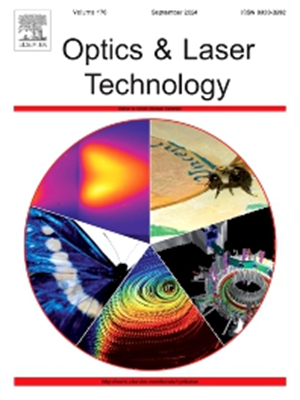1.2 μm级联拉曼光纤振荡器,功率超过1.3 kW
IF 5
2区 物理与天体物理
Q1 OPTICS
引用次数: 0
摘要
工作在1.2 μm波长区域的高功率光纤激光器对于中红外泵浦源和非线性变频应用至关重要。然而,利用掺稀土(RE)光纤激光器在这一特定波长产生相干发射遇到了明显的技术障碍。在探索的各种方法中,级联拉曼光纤激光器(crfl)成为一种特别有前途的策略。本研究展示了在纯被动梯度折射率(GRIN)光纤配置下的级联拉曼激光,利用两对光纤布拉格光栅和1080 nm泵浦下的级联拉曼增益。第二个Stokes元件在1185 nm处的输出功率超过1.3 kW, 3db线宽为1.65 nn,标志着在1185 nm波段上演示的第一个千瓦级级联拉曼光纤振荡器。光束质量分析确认了1.3 kW时80%的基模含量,在多模光纤架构下实现高亮度应用。这一成果不仅验证了级联拉曼转换实现1.2 μm波段高输出功率光纤激光器的可行性,而且为开发其他扩展波长区域的高功率激光源提供了可行的途径和重要的参考。本文章由计算机程序翻译,如有差异,请以英文原文为准。
1.2 μm cascaded Raman fiber oscillator exceeding 1.3 kW
High-power fiber lasers operating in the 1.2 μm wavelength region are critical for mid-infrared pump sources and nonlinear frequency conversion applications. However, generating coherent emission at this specific wavelength using rare-earth (RE) doped fiber lasers encounters notable technical obstacles. Among the diverse approaches explored, cascaded Raman fiber lasers (CRFLs) emerge as a particularly promising strategy. This study demonstrates cascaded Raman lasing in a purely passive graded-index (GRIN) fiber configuration, leveraging two pairs of fiber Bragg gratings and cascaded Raman gain under 1080 nm pumping. The output power of the second Stokes component at 1185 nm with a 3-dB linewidth of 1.65 nn has exceeded 1.3 kW, marking the first kilowatt-level cascaded Raman fiber oscillator demonstrated in the 1185 nm wavelength band. Beam quality analysis confirms >80 % fundamental mode content at 1.3 kW, enabling high-brightness applications despite multimode fiber architecture. This achievement not only validates the feasibility of cascaded Raman conversion for realizing high-output power fiber lasers in the 1.2 μm band but also provides a viable approach and significant reference for developing high-power laser sources in other extended wavelength regions.
求助全文
通过发布文献求助,成功后即可免费获取论文全文。
去求助
来源期刊
CiteScore
8.50
自引率
10.00%
发文量
1060
审稿时长
3.4 months
期刊介绍:
Optics & Laser Technology aims to provide a vehicle for the publication of a broad range of high quality research and review papers in those fields of scientific and engineering research appertaining to the development and application of the technology of optics and lasers. Papers describing original work in these areas are submitted to rigorous refereeing prior to acceptance for publication.
The scope of Optics & Laser Technology encompasses, but is not restricted to, the following areas:
•development in all types of lasers
•developments in optoelectronic devices and photonics
•developments in new photonics and optical concepts
•developments in conventional optics, optical instruments and components
•techniques of optical metrology, including interferometry and optical fibre sensors
•LIDAR and other non-contact optical measurement techniques, including optical methods in heat and fluid flow
•applications of lasers to materials processing, optical NDT display (including holography) and optical communication
•research and development in the field of laser safety including studies of hazards resulting from the applications of lasers (laser safety, hazards of laser fume)
•developments in optical computing and optical information processing
•developments in new optical materials
•developments in new optical characterization methods and techniques
•developments in quantum optics
•developments in light assisted micro and nanofabrication methods and techniques
•developments in nanophotonics and biophotonics
•developments in imaging processing and systems

 求助内容:
求助内容: 应助结果提醒方式:
应助结果提醒方式:


